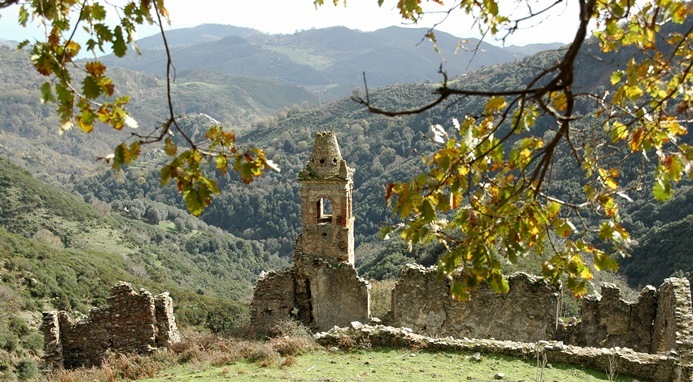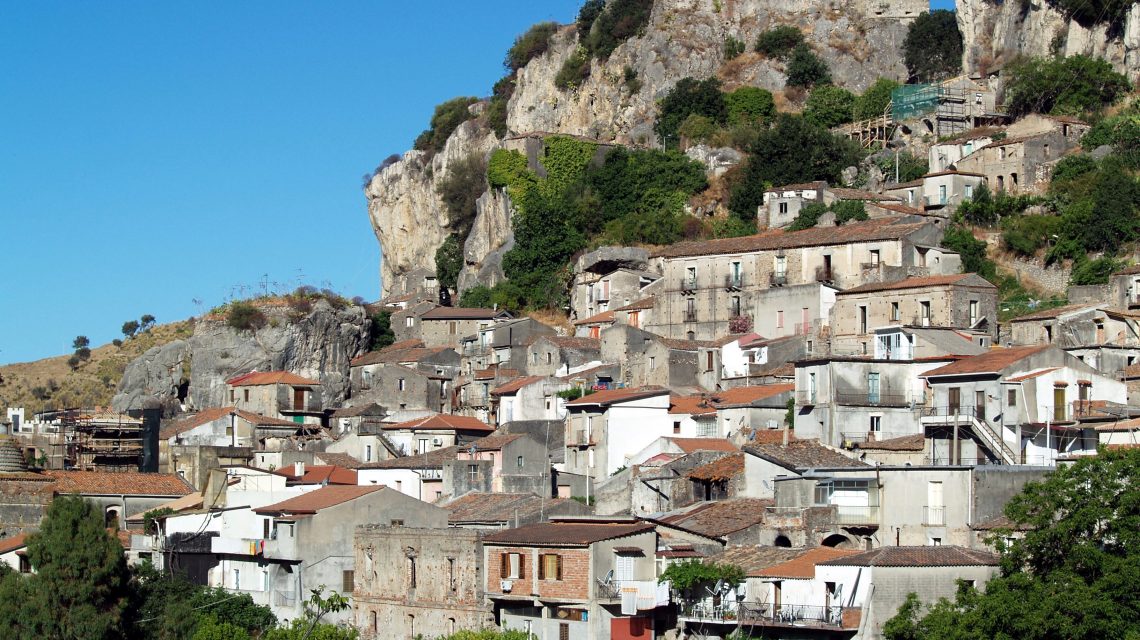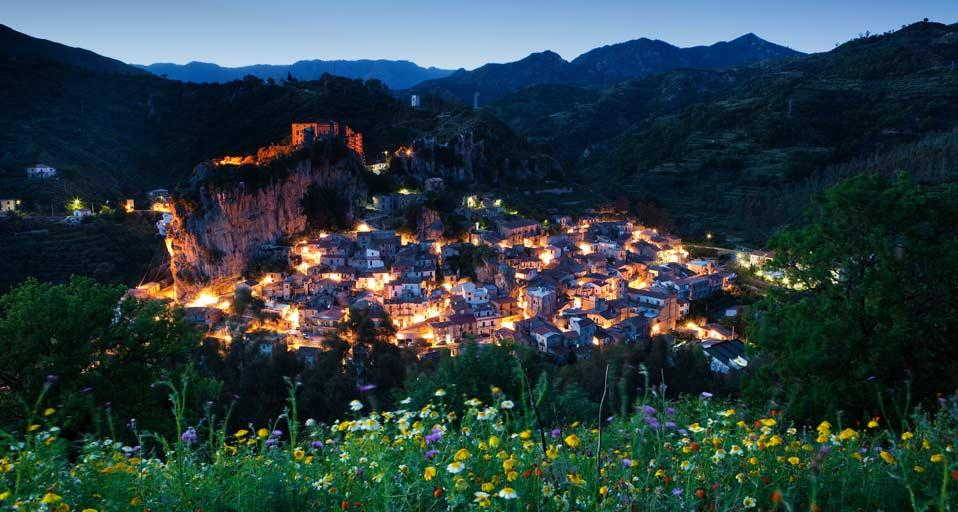Porto Palizze, this bay was called between the seventeenth and nineteenth centuries, not by chance preserves a seafront that although very small, is the only one to have marine life even in winter.
There is no trace of the coastal moorings, except for a sighting tower, dated 1595, called Torre Mozza, because of the squashing of the upper parts of the structure, of which only one corner remains, set on a rectangular base.
The village is divided by the river in two districts: Murrotto and Stracia, clearly allusive to testimonies of the past. From both districts there are two roads that lead respectively to the villages of Palizzi Superiore and Pietrapennata, through a path dotted with the most precious vineyards of the Grecanica area. But the beating heart of the municipality of Palizzi is the historic center located higher up, about 272 m s.l.m. compared to the Marina district.
THE NAME
It derives according to some from the Greek politsion with a diminutive sense of polis (city), according to others from the Greek polìscin, which seems to mean “shady place”.
HISTORY
Palizzi brings together all the elements of the fairy-tale villages: a castle on a cliff, a medieval village at its feet and a saddle-shaped bridge that since the fourteenth century dominates a stream.
Documented for the first time in the mid-eleventh century, among the properties of the monastery of Sant’Angelo di Valle Tuccio, Palizzi was a figure, at the end of the next century, among the houses of the county of Bova. In 1322 the fiefdom was sold by Bartolomeo Busca to Guglielmo Ruffo di Calabria, count of Sinopoli, owner of a vast estate that included a large part of southern Calabria. At his death, his nephew Antonello had to divide the baron with his uncle Folco, thus generating the branch of the Ruffo di Palizzi – Brancaleone, survived for four generations, not without abrupt intervals, determined by the dynastic contrasts between Anjou and Aragon.
In 1479 Palizzi was in the hands of Bernardino Maldà de Cadorna as early as 1498 he returned to the Ruffo, to whom we owe the work on the north eastern side of the castle, where the signs of architectural changes are evident, important in the Kingdom of Naples by Francesco Giorgio Martini and Bernardo Rossellino. The marriage of Geronima Ruffo and Alfonso de Ayerbo d’Aragona in 1505, inaugurated a repeated series of dynastic alternations that saw the baronial pass first to Triano Spinelli, then back to the Ayerbo d’Argona and then in 1580 to the Roman of Messina.
It is up to Giacomo Colonna Romano to insert the heraldic coat of arms that stands out at the entrance to the castle, perhaps placed at the end of a restoration campaign. Property of the Arduino di Messina since 1666, the land of Palizzi was sold in 1751 to the De Blasio, who maintained it until 1806, bringing considerable renovations to the castle, which in part define the current appearance. The imposing building overlooks a village full of medieval atmospheres. Very narrow streets and endless steps lead to the main square where the Church of Sant’Anna faces.
DISCOVER THE TOWN
Immersed in a superb nature, the village is perched on a sandstone cliff at the foot of the imposing castle.
The town immediately fascinates the visitor for its unique medieval center: “palazzziate and solarate” of imaginative architectural solutions, kettles, underpasses, staircases and ceramide roofs (curved tiles) give the vision of an almost untouched natural landscape.
The walk starts from the bridge of the “schiccio”, under which flow the waters of the stream of Palizzi, from which you can see an old mill.
Once you reach the center of the town, you can visit the parish church of Sant’Anna which houses an interesting corpus of statues of saints and madonnas, including the wooden sculpture of the saint titular, commissioned in 1827 by the last baron of Palizzi. Tiberio De Blasio.
At the end of the apse stands the marble statue of Sant’Anna and the Madonna, among the first all-round works in the diocese of Bova, within the end of the second half of the sixteenth century.
Of the same period, but of different artistic matrix, is the dome that is grafted into the left aisle, evidence of Byzantine architectural persistence, clearly perceptible to the exterior in the use of the shard to lighten the structure. In this parish, the bishop Stavriano, established (1574) the first Latin community of the diocese, to which he devolved all the properties of the churches of Palizzi.
Only Latin clerics could join. The Greeks, so excluded and reduced to poverty, survived by dedicating themselves to agriculture and pastoralism. They died leaving heirs who never dreamed of succeeding their parents’ ministry, irreparably defeated by events.
Through the alleys characterized by special architectural anti-seismic solutions, we reach the castle of the Middle Ages, a recognized national monument by the Ministry for Cultural Heritage.
Recently built the marine village that extends over the magnificent nesting nesting coastline of the Caretta Caretta Marine Turtles. Palizzi, in fact, is a common leader of the Life Caretta Calabria project which has been part of the Life program of DG Environment of the European Commission since 2013.
PALIZZI WINE IGT
The territory of Palizzi is distinguished by the abundance of vines; there is produced an excellent red wine recognized by the IGT brand, which can be tasted in the characteristic wine cellars of the town, named for the “city of wine”.
Known and appreciated throughout the area Palizzi is a generous red, excellent with roasts, with traditional and elaborate dishes based on sauces and meat from goat and pork, stews, game, well-matured cheeses.
The Village of Pietrapennata
The small village of Pietrapennata a few miles north of Palizzi Superiore, owes its name to the rocky ridges that dominate it. The oral tradition indicates the village founded by the Knights of Malta, certainly before the small town was destroyed in 1696 as a document conserved in the Reggio archives. The presence of the Knights of Malta seems to be connected to the title of the nearby church of the Madonna dell’Alica, according to some referable to the celebration of the victory of Lepanto, 1571.
More specifically, however, the title could be associated with the miracle of the Madonna della Vittoria. Rome on May 8, 1622, the day in which the Virgin is still commemorated today, in the Church of the Holy Spirit. Here, in 1887, the sculpture of the Madonna dell’Alica was transferred, together with the entire altar, probably made with medieval reuse materials, and refined in 1762 by an elegant antependium in committed marbles. The sculpture of the Madonna with Child, to be related to the Mazzolo workshop, or that of Gagini, must certainly date back to the years of the Latinization of the Bovine diocese (1572), since an eighteenth-century source recalls the church built by the Ajerbo d’Aragona, after that a cart of oxen had miraculously led to this hill the statue of the Madonna dell’Alica, disembarked on the coast of Palizzi while being transported to Sicily.
Church of the Madonna dell’Alica
The ancient monastic site of the Acica can be reached by a path that was born near the cemetery of the small village. The road leads to a ridge that shows in its entirety the circular shape of the end of Calabria, from which the church is also visible, lying on the side of a hill.
It is a single-aisle building with a cuspidate bell tower attached to it, embellished with celestial majolica, dating back to the early decades of the seventeenth century. On the sides of the southern wall emerge the remains of a portico or cloister of a Basilian hermitage, identified by some in the monastery of Sant’Ippolito or in a granite of the latter.





